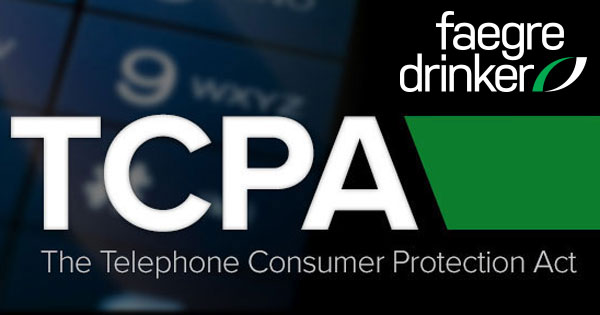On Wednesday the Joint Petitioners and the FCC filed their final briefs in the consolidated appeal from the FCC’s July 10, 2015 Declaratory Ruling and Order, which is pending in the United States Court of Appeals for the D.C. Circuit. Their briefs are summarized below.
The Joint Petitioners’ Final Brief
The Joint Petitioners’ final brief reiterates their primary challenges to the FCC’s rulings regarding the definition of an ATDS, the identity of the “called party” from which consent must be obtained, and the extent of that party’s ability to revoke that consent.
First, the Joint Petitioners ground their ATDS argument in the statutory definition: “equipment which has the capacity – (A) to store or produce telephone numbers to be called, using a random or sequential number generator; and (B) to dial such numbers.” 47 U.S.C. § 227(a)(1). They note that the definition begs two questions: “what does it mean for equipment to have the ‘capacity’ to perform the functions of an ATDS, and what are those functions?” Pet’rs’ Br. at 21. As for the meaning of “capacity,” they cite dictionary definitions and other federal statutes and argue that “[e]very relevant principle of statutory interpretation confirms that ‘capacity’ refers to what equipment can do as is, not what it might be able to do if changed.” Id. They argue that the FCC’s contrary interpretation is virtually limitless—so much so that it had to use “a rotary phone as an example of technology that would not be covered.” Id. at 24. As for the characteristic functionalities of an ATDS, they argue that equipment does not qualify as an ATDS unless it can automatically: (1) generate random or sequential numbers; (2) use the generator to store or produce numbers to be called; and (3) dial those numbers. Id. at 31. They argue that the FCC’s statements about and examples of those functionalities are inconsistent and incoherent. Id. at 34.
Second, the Joint Petitioners argue that interpreting “called party” to mean a “current subscriber” or “customary user” would eviscerate the TCPA’s protection of consensual communications, thereby “upending the balance Congress struck between protecting consumers and safeguarding beneficial calling practices.” Id. at 39. They note that 100,000 cell phone numbers are reassigned on a daily basis and that, as there is no reliable method for tracking all of those reassignments, even the most scrupulous callers face unavoidable liability. Id. at 40. They argue that the FCC’s one-call safe harbor fails to address this problem because “it would arbitrarily impose liability for later calls regardless whether the first call provides any reason to believe that number has been reassigned….” Id. at 51.
Third, the Joint Petitioners argue that allowing consumers to revoke consent by any “reasonable” means under the “totality of the facts and circumstances” is so “impractical” that it is arbitrary and capricious. Id. at 55. They also argue that any suggestion that callers and consumers cannot contractually agree on the “reasonable” methods for revoking consent would be unlawful because the FCC has no statutory authority to impose such a restriction. See id. at 61.
The FCC’s Final Brief
The FCC’s final brief not surprisingly takes the opposite positions. First, the FCC argues that its reading of the ATDS definition is reasonable because Congress did not use the word “present” in the definition, and because there are alternate dictionary definitions that suggest that “capacity” should be read as “potential capacity.” Resp’t’s Br. at 26. It also argues that a narrower reading would “create problems for enforcing the TCPA’s privacy protections,” and dismisses the concern that its interpretation could be read as applying to smartphones, apparently because no one thought to file a formal petition seeking a declaration that smartphones are not ATDSs. Id. at 31-32. As for its statement that the mere capacity to dial a stored list of numbers is enough to trigger the ATDS definition, it argues that its statement was consistent with prior FCC rulings that Congress has implicitly ratified. Id. at 36.
Second, the FCC argues that interpreting “called party” as the “current subscriber” or “customary user” is reasonable as a matter of law and defensible as a matter of policy. Id. at 54. Noting that the phrase “intended recipient” does not appear in the statute, it argues that the Joint Petitioners’ interpretation “‘would turn the TCPA’s consumer protection on its head’ by ‘placing the burden on new subscribers to inform the caller they are the wrong party and that they do not consent.’” Id. at 56. Although it again acknowledges that its interpretation creates an unavoidable risk of liability, and that its one-call safe harbor will “reduce” but “not eliminate” that risk, it defends that position because it believes that that risk may motivate callers to create tools that make compliance possible at some point in the future. Id. at 60.
Third, the FCC argues that it has “broad authority” to dictate how consumers can revoke consent and, since “Congress did not directly address in the TCPA whether callers can make consumers waive (in whole or in part) their right to revoke consent, it falls to the [FCC] to fill this statutory gap….” Id. at 63. It contends that, by prohibiting callers from unilaterally dictating revocation methods, and by allowing consumers to revoke consent by any reasonable means, it has given the term “consent” its “most appropriate meaning within the consumer-protection goals of the TCPA.” Id. at 63.
Next Steps
Briefing is now complete and oral argument should soon be scheduled. We will continue to monitor the docket and will report any significant developments

